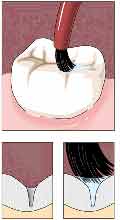Explaining Dental Sealants
A dental sealant is a plastic coating applied to the chewing surfaces of back teeth. Grooves in these teeth are so narrow that a toothbrush cannot fit into the spaces to remove plaque (what is plaque?). Dental sealants help prevent dental decay in the grooves.
84% of the cavities that kids get are in the grooves of their teeth.
Our Kids Have Sealants on Their Teeth - We Think Yours Should Too! After all, it's exactly what we would recommend for our family and friends!
Why Dental Sealants Are Important...
Sealants can provide 100% protection from dental decay or "cavities" on the chewing surface. Research has shown that when placed over very minimal dental decay, the decay will no longer progress
Who Should Get Dental Sealants?
While children are usually the main focus for dental sealants, more and more dentists and hygienists are learning that sealants can also help adults keep their teeth healthy and the chewing surfaces decay-free.
- Children should receive sealants on permanent molars as soon as they erupt (about ages 6 and 12 years).
- Adults who have deep grooves in their back teeth, molars that have not been filled or restored, and those whose hygienist see a risk factor for decay should have sealants placed.
- If a tooth already has a filling, then it does not get a dental sealant
Here's How We Do It....

- First - The tooth is etched with a mild acid to create retention for the sealant, then rinsed and air dried.
- Second - The liquid sealant is painted into the grooves of the teeth.
- Third - A high intensity light is used to activate the liquid plastic to harden.
What Else Should I Know?
How Long Will My Sealants Last?While they may last up to 10 years, 2 to 4 years is a more reasonable estimate. Sealants can be highly effective in protection against cavities provided the sealant is continuously monitored by a dentist. Sealants should be checked by a dentist during regular check ups and if needed they can be re-applied.
|
Are Sealants Safe For My Family?Sealants are simple, painless, and require no drilling.
If They Sealants Are So Great, Why Not Put Them On Every Tooth?The liquid plastic is designed to flow into and fill the pits and grooves of the teeth. The plastic does not work on the smooth surfaces of the teeth, like the fronts and backs and sides of the teeth.
|
